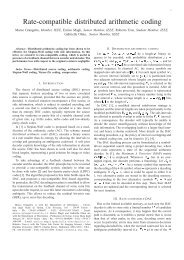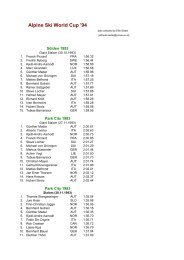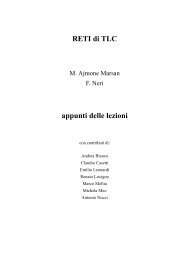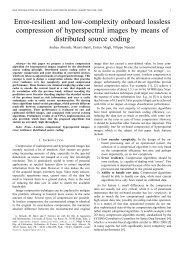IEEE TRANSACTIONS ON GEOSCIENCE AND REMOTE SENSING (SUBMITTED DEC. 2005) 27 Fig. 16. Classification result respectively on the original image (left), on the compressed image with full-complexity KLT at 1 bpp (center), on the compressed image with low-complexity KLT (ρ =0.01) at 1 bpp (right). The number of clusters is equal to 3. The best spectral trans<strong>for</strong>m has turned out to be the KLT. In order to make this trans<strong>for</strong>m computationally feasible, we have proposed a low-complexity version with comparable per<strong>for</strong>mance. The degree of computational saving and the related per<strong>for</strong>mance loss can be tuned to the specific needs of each application. The low-complexity KLT, along with a hybrid wavelet-based scheme, have been integrated into a JPEG 2000 Part 2 compliant scheme. Tests have been carried out on AVIRIS <strong>data</strong>, and comparisons have been per<strong>for</strong>med with respect to 3D-SPIHT and SPECK. The proposed KLT-based scheme achieves significant per<strong>for</strong>mance gains with respect to the hybrid schemes and 3D-SPIHT; it outper<strong>for</strong>ms SPECK by 5 to 10 dB in PSNR. An end-to-end complexity reduction of about three times can be achieved using the low-complexity KLT, with a minor per<strong>for</strong>mance loss (about 0.5 dB). This trans<strong>for</strong>m is only about 40% more complex than 3D wavelets, but has significantly better per<strong>for</strong>mance. A quality assessment of compressed images has also been carried out by evaluating the effects of several <strong>lossy</strong> <strong>compression</strong> schemes on the results of SAM classification. It turns out that, <strong>for</strong> this application, PSNR is a good indicator of classification per<strong>for</strong>mance, so that the proposed scheme is still the highest-per<strong>for</strong>mance one by a large margin. REFERENCES [1] D.S. Taubman and M.W. Marcellin, JPEG2000: Image Compression Fundamentals, Standards, and Practice, Kluwer, 2001. [2] S. Lim, K. Sohn, and C. Lee, “Compression <strong>for</strong> <strong>hyperspectral</strong> images using three dimensional wavelet trans<strong>for</strong>m,” in Proc. of IGARSS - IEEE International Geoscience and Remote Sensing Symposium, Sydney, Australia, 2001. [3] Y. Tseng, H. Shih, and P. Hsu, “Hyperspectral image <strong>compression</strong> using three-dimensional wavelet trans<strong>for</strong>mation,” in Proceedings of the the 21st Asian Conference on Remote Sensing (ACRS), Taipei, Taiwan, 2000.
IEEE TRANSACTIONS ON GEOSCIENCE AND REMOTE SENSING (SUBMITTED DEC. 2005) 28 [4] A. Kaarna and J. Parkkinen, “Comparison of <strong>compression</strong> methods <strong>for</strong> multispectral images,” in Proc. of NORSIG - Nordic Signal Processing Symposium, Kolmarden, Sweden, 2000, vol. 2, pp. 251–254. [5] G.P. Abousleman, M.W. Marcellin, and B.R. Hunt, “Compression of <strong>hyperspectral</strong> imagery using the 3-D DCT and hybrid DPCM-DCT,” IEEE Transactions on Geoscience and Remote Sensing, vol. 33, no. 1, pp. 26–34, Jan. 1995. [6] D. Markman and D. Malah, “Hyperspectral image <strong>coding</strong> using 3D trans<strong>for</strong>ms,” in Proc. of ICIP - IEEE International Conference on Image Processing, Thessaloniki, Greece, 2001. [7] M.D. Pal, C.M. Brislawn, and S.R. Brumby, “Feature extraction from <strong>hyperspectral</strong> images compressed using the JPEG-2000 standard,” in Proc. of SSIAI - IEEE Southwest Symposium on Image Analysis and Interpretation, Santa Fe, New Mexico, 2002. [8] M.D. Pal and C.M. Brislawn S.P. Brumby, “Feature extraction <strong>for</strong>m <strong>hyperspectral</strong> images compressed using the JPEG-2000 standard,” in Proc. of SSIAI Southwest Symposium on Image Analysis and Interpretation, Santa Fe, New Mexico, 2002. [9] S. Lim, K.H. Sohn, and C. Lee, “Principal component analysis <strong>for</strong> <strong>compression</strong> of <strong>hyperspectral</strong> images,” in Proc. of IGARSS - IEEE International Geoscience and Remote Sensing Symposium, Sydney, Australia, 2001. [10] X. Tang, C. Sungdae, and W.A. Pearlman, “3D set partitioning <strong>coding</strong> methods in <strong>hyperspectral</strong> image <strong>compression</strong>,” in Proc. of ICIP - IEEE International Conference on Image Processing, Barcelona, Spain, 2003. [11] X. Tang and W.A. Pearlman, “Three-dimensional wavelet-based <strong>compression</strong> of <strong>hyperspectral</strong> images,” in Hyperspectral Data Compression. Kluwer Academic Publishers, 2005. [12] J.A. Sagri, A.G. Tescher, and J.T. Reagan, “Practical trans<strong>for</strong>m <strong>coding</strong> of multispectral imagery,” IEEE Signal Processing Magazine, pp. 32–43, Jan. 1995. [13] P.L. Dragotti, G. Poggi, and A.R.P. Ragozini, “Compression of multispectral images by three-dimensional SPIHT algorithm,” IEEE Transactions on Geoscience and Remote Sensing, vol. 38, no. 1, pp. 416–428, Jan. 2000. [14] L. Chang, C. Cheng, and T. Chen, “An efficient adaptive KLT <strong>for</strong> multispectral image <strong>compression</strong>,” in Proceedings of 4th IEEE Southwest Symposium on Image Analysis and Interpretation, Austin, TX, 2000. [15] P. Hao and Q. Shi, “Reversible integer KLT <strong>for</strong> progressive-to-lossless <strong>compression</strong> of multiple component images,” in Proc of IEEE International Conference on Image Processing, 2003, Barcelona, Spain, 2003. [16] B. Penna, T.Tillo, E. Magli, and G. Olmo, “Progressive 3D <strong>coding</strong> of <strong>hyperspectral</strong> images based on JPEG 2000,” IEEE Geoscience and Remote Sensing Letters, to appear Jan. 2006. [17] E. Christophe, D. Léger, and C. Mailhes, “Quality criteria benchmark <strong>for</strong> <strong>hyperspectral</strong> imagery,” IEEE Transactions on Geoscience and Remote Sensing, vol. 43, no. 9, pp. 2103–2114, Sept. 2005. [18] V. Guralnik and G. Karypis, “A scalable algorithm <strong>for</strong> clustering protein sequences,” in Workshop on Data Mining in Bioin<strong>for</strong>matics, 2001. [19] JPEG 2000 Part 2 - Extensions, Document ISO/IEC 15444-2. [20] M. Vetterli and J. Kovacevic, Wavelet and Subband Coding, Pretince Hall, 1995. [21] R.R. Coifman and M.V. Wickerhauser, “Entropy-based algorithms <strong>for</strong> best basis selection,” IEEE Transactions on In<strong>for</strong>mation Theory, vol. 38, no. 2, pp. 713–718, Mar. 1992. [22] K. Ramchandran and M. Vetterli, “Best wavelet packet bases in a rate-distortion sense,” IEEE Transactions on Image Processing, vol. 2, no. 2, pp. 160–175, Apr. 1993. [23] V.K. Goyal, “Theoretical foundations of trans<strong>for</strong>m <strong>coding</strong>,” IEEE Signal Processing Magazine, vol. 18, no. 5, pp. 9–21, 2001. [24] I.S. Dhillon, ANewO(N 2 ) Algorithm <strong>for</strong> the Symmetric Tridiagonal Eigenvalue/Eigenvector Problem, Ph.D. Thesis, University of Cali<strong>for</strong>nia, Berkeley, 1997.






